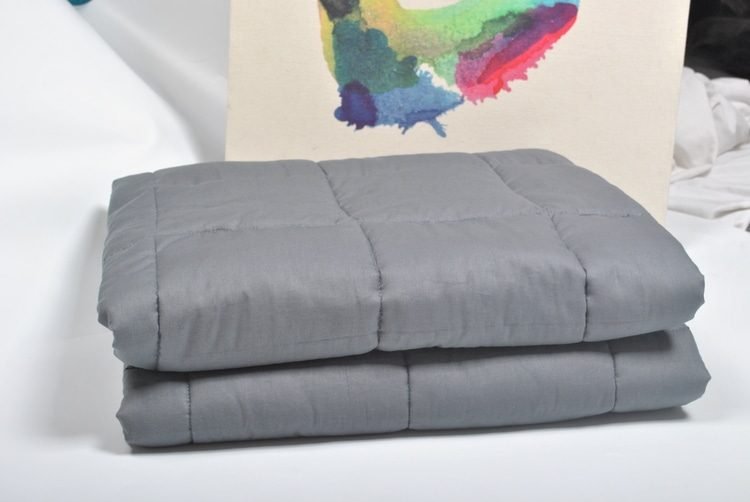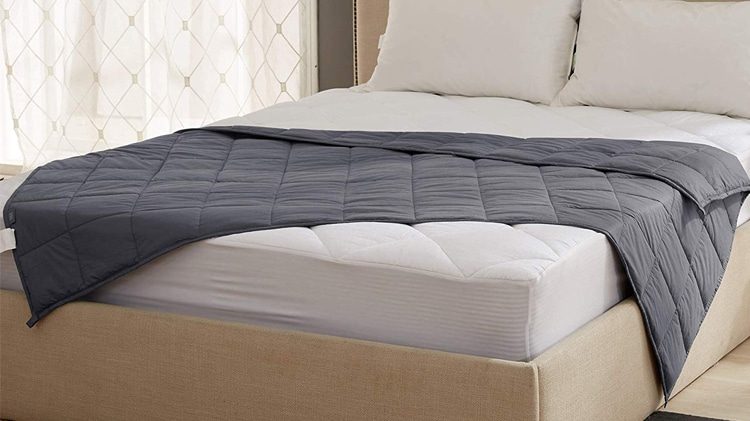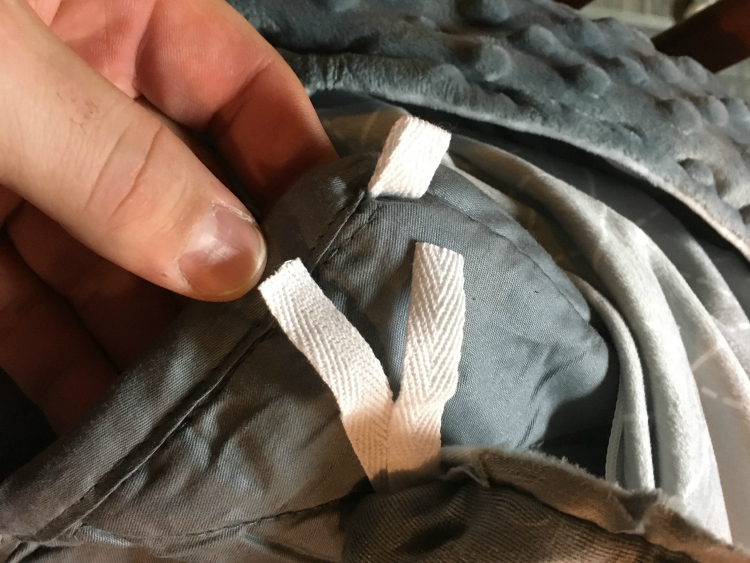They’re called weighted blankets for a good reason – they’re much heavier than your regular blankets!
If you follow this blog, you certainly would have read about the plethora of benefits of using weighted blankets for promoting better sleep and relaxation.
Even if you’ve never owned one, you might have heard about someone who tried out a weighted blanket and remarked on how it dramatically changed their sleeping experience.
At some point, you may have wondered:
What goes into a weighted blanket?
What are the materials used that make it so heavy?
A weighted blanket is essentially composed of a quilted fabric with embedded ‘pockets’ stuffed with a filler material to increase its weight. The stuffing is primarily responsible for the extra weight the blanket provides.
A weighted blanket has numerous benefits, not just for people with special needs like those on the Autism spectrum and those with sensory disorders.
Even regular people who have trouble relaxing due to anxiety, insomnia, and other issues can benefit from the deep pressure sensory input they provide.
In this article, we’ll be discussing what exactly goes into making a weighted blanket.
Hopefully, by the end of your reading, you could consider yourself a ‘weighted blanket guru’ who’s able to enlighten others on what weighted blankets are made of.
As an added benefit, you’ll be able to make a more informed buying decision when you shop for a weighted blanket for yourself or a loved one!
Weighted blanket fabric
The blanket itself is always made of fabric of some kind, so we’ll be discussing that first.
The first thing you need to know is that there’s a wide range of fabric that could be used to design a weighted blanket. It could basically be made from any type of fabric at all.
This means that you always have a lot to choose from. However, before picking a particular fabric, you’ll need to consider:
- The purpose of buying a weighted blanket
- The type of sleep/relaxation issues you have, and
- Your personal preferences.
That being said, the most common fabrics used for making weighted blankets are:
- Pure cotton
- Cotton blends
- Polyester
- Fleece
- Flannel
- Mink fabric
- Rayon-cotton blend etc.
The above-listed types of fabric all have their unique textures, thickness, and softness that strongly influence the buying decisions of most users.

Not all fabrics have the same weight, however. For instance, polyester is usually much lighter than pure and blended cotton. Rayon-linen blend fabric will be heaviest of them all.
A Compromise: Comfort vs. Durability
The nature of a particular material chosen plays a major role in giving you the most comfortable weighted blanket experience. However, not all fabrics are equal in durability.
Choosing a weighted blanket could often be a trade-off between picking a blanket that will be a long-term investment and having one that caters to your unique needs and personal taste.
Especially for people with heat and texture sensitivities, fabrics need to provide optimum comfort to enable them to sleep comfortably through the night.
Others who have no known sensitivity issues or special needs can simply pick a fabric based on durability and good aesthetics.
‘Weighting’ the blanket
If you used a knife to rip open a weighted blanket, what you’ll find inside will be white solids with a firm texture. These are known as the ‘stuffing’ for the blankets.
The weight of a weighted blanket depends on the nature of the fabric used and the amount of stuffing that went into the material.
The more the quantity of stuffing put into a weighted blanket, the heavier it becomes. Stuffing of a weighted blanket is done by highly skilled artisans.
The idea is to apply a uniform amount of the material to each pocket so that the weight is evenly distributed.
The fabric to be used to make the blanket is usually quilted, rather than using regular threading like in regular sleep blankets.
By ‘quilted’ it means that layers of the weighted blanket fabric are sewn together to create a thicker, denser material to hold the extra weight.
The reason why the material is quilted is to better support the overall weight of the blanket and prevent it from ripping at the seams.
Inner and outer covers
More often than not, two different types of fabric will be used for the inner and outer parts of the blanket.
For example, a blanket might be made of fleece on the outside with a cotton or flannel fabric on the inside. One reason why this is done is to improve breathability.

Weighted blanket stuffing
Fillings simply refer to the material used to stuff the blanket to increase its weight. The two most common types of stuffing used for making weighted blankets are:
- Polymer pellets
- Glass beads
Polymer pellets
Polymer pellets are tiny, plastic solids with a little individual weight and a regular shape. They are made non-toxic polypropylene.
The type of Poly pellets used to make weighted blankets is similar to those used in stuffed kids’ toys. The beads are usually colorless and non-toxic. They feel hard when touched.
These tiny beads added to the individual pockets of the material make the weighted blanket heavier by evenly distributing weight over the length and width of the material – ensuring that no side is heavier than the other.
People who have texture sensitivities might prefer a ‘smoother’ stuffing that won’t feel so bumpy against the skin.
Right away, we’ll be discussing an alternative stuffing for weighted blankets – Glass beads.
Glass Beads
Glass beads are exactly what they sound like – small pebbles made of glass.
Not to worry, the particular type of glass beads used in crafting weighted blankets have smooth, round surfaces with no jagged edges.
Glass beads are tougher than Poly pellets simply because they’re made from glass. They’re much heavier, too. Many people remark that weighted blankets stuffed with glass beads feel quite luxurious.
Glass beads have a very fine texture that feels almost like touching sand on a beach. They make for a blanket that is smooth and very consistent.
When glass beads are used to stuff a weighted blanket fabric, the result is a less ‘bumpy’ profile. This is because the individual beads are tinier than Poly pellets.
Glass beads are much heavier than Poly pellets of the same quantity and will typically be needed in smaller amounts. These beads are typically non-toxic and eco-friendly.
Poly Pellets vs. Glass Beads – Which is better?
People ask this question all the time – they would like to find out which weighted blanket filling is more suitable for them.
I think it’s mostly a matter of personal preference, although your unique needs and sensitivities have a lot to do with the type of stuffing you go for ultimately.
For some, the ‘grainy’ feeling of Poly pellets inside a weighted blanket can be very uncomfortable. People with tactile sensitivities or a sensory processing disorder may find it over-stimulating.

Others find weighted blankets made with glass beads more comfortable and less stimulating to the touch.
Choosing the right fabric for your stuffing
The type of fabric the blanket is made of will determine whether you actually ‘feel’ the stuffing or not.
For example, fleece is a thick material that can considerably ‘mask’ the rough texture of both poly pellets and glass beads.
Polyester on the other hand, has a slimmer profile that will cause the hardness of the stuffing to be felt more easily.
If you have texture sensitivities or SPD, you’ll want to go for either:
- A thick fabric with poly pellets as the stuffing
- A light or thick fabric stuffed with glass beads
How a Weighted blanket is put together
The first step in putting together a weighted blanket is to choose a suitable fabric. After that is done, the material is cut into the individual pieces that will make up the blanket.
Although individual fabric parts are stitched together in the same way as regular items of clothing, quilting is done to give the blanket more subtle padding and seal the fillings in better.
As mentioned earlier, quilting gives the weighted blankets more support to handle the increased weight. This is usually done by highly skilled workers.
After the fabric parts have been stitched, ‘pockets’ of equal dimensions are embedded under the outer cover and throughout the length and width of the fabric. These pockets are filled with equal volumes of the stuffing.
After stuffing has been done, the pockets are sewn together and the material is turned to the reverse side, giving the blanket a more padded profile. The blanket can then be packaged for shipping.
Last Words
Thanks for reading up to this point! You should now have a good idea about what goes into making a weighted blanket. Equipped with this information you’ll know what to look out for when choosing one.
You can also share this knowledge with friends and loved ones who are looking to buy a weighted blanket. It should help them to make more informed buying decisions based on their personal needs.

